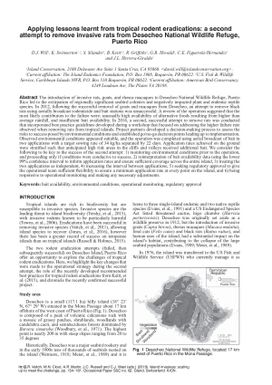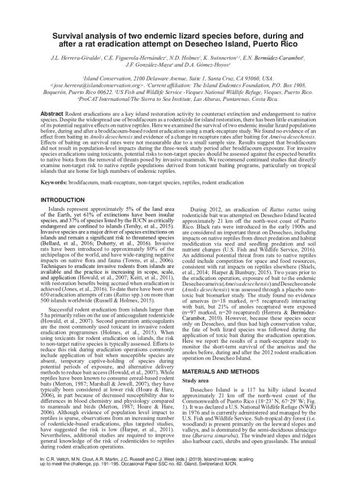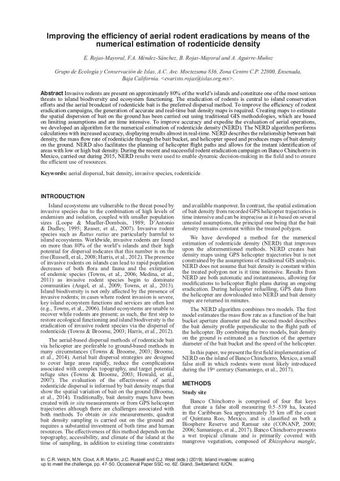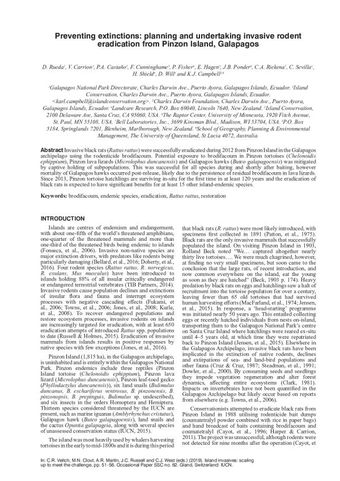Applying lessons learnt from tropical rodent eradications: a second attempt to remove invasive rats from Desecheo National Wildlife Refuge, Puerto Rico
- Description:
- The introduction of invasive rats, goats, and rhesus macaques to Desecheo National Wildlife Refuge, Puerto Rico led to the extirpation of regionally signifi cant seabird colonies and negatively impacted plant and endemic reptile species. In 2012, following the successful removal of goats and macaques from Desecheo, an attempt to remove black rats using aerially broadcast rodenticide and bait stations was unsuccessful. A review of the operation suggested that the most likely contributors to the failure were: unusually high availability of alternative foods resulting from higher than average rainfall, and insufficient bait availability. In 2016, a second, successful attempt to remove rats was conducted that incorporated best practice guidelines developed during a workshop that focused on addressing the higher failure rate observed when removing rats from tropical islands. Project partners developed a decision-making process to assess the risks to success posed by environmental conditions and established go/no-go decision points leading up to implementation. Observed environmental conditions appeared suitable, and the operation was completed using aerial broadcast of bait in two applications with a target sowing rate of 34 kg/ha separated by 22 days. Application rates achieved on the ground were stratified such that anticipated high risk areas in the cliff s and valleys received additional bait. We consider the following to be key to the success of the second attempt: 1) monitoring environmental conditions prior to the operation, and proceeding only if conditions were conducive to success, 2) reinterpretation of bait availability data using the lower 99% confidence interval to inform application rates and ensure sufficient coverage across the entire island, 3) treating the two applications as independent, 4) increasing the interval between applications, 5) seeking regulatory approval to give the operational team sufficient flexibility to ensure a minimum application rate at every point on the island, and 6) being responsive to operational monitoring and making any necessary adjustments.
- Display date:
- 2019
- Collections:
- Secretariat of the Pacific Regional Environment Programme (SPREP)
- Publisher:
- Secretariat of the Pacific Regional Environment Programme (SPREP)
- Content partner:
- Secretariat of the Pacific Regional Environment Programme (SPREP)
- Availability:
- Not specified
-
Copyright status: All rights reservedFind out more about what you are able to do with this itemThis item is all rights reserved, with means you'll have to get permission from Secretariat of the Pacific Regional Environment Programme (SPREP) before using it. For more information, please see our use and reuse page.What can I do with this item?Non-infringing useNZ copyright law does not prevent every use of a copyright work, and this item may be hosted by an international institute or organisation. You should consider what you can and cannot do with a copyright work.No sharingYou may not copy and/or share this item with others without further permission. This includes posting it on your blog, using it in a presentation, or any other public use.No modifyingYou are not allowed to adapt or remix this item into any other works.No commercial useYou may not use this item commercially.
Related items
Welcome and warm Pasifik greetings
The information on this site has been gathered from our content partners.
The names, terms, and labels that we present on the site may contain images or voices of deceased persons and may also reflect the bias, norms, and perspective of the period of time in which they were created. We accept that these may not be appropriate today.
If you have any concerns or questions about an item, please contact us.



